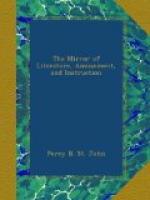S.I.B.
[3] Jane Seymour, or as is
sometimes written de Sancto Mauro, eldest
daughter
of Sir John Seymour, Knight, and Margaret, daughter
of
Sir
Thomas Wentworth, of Nettlestead, in Suffolk was born
at her
father’s
seat of Wolf Hall, in Wiltshire. From her great
accomplishments,
and her father’s connexions at court, (he being
Governor
of Bristol Castle, and Groom of the Chamber to Henry
VIII.)
she was appointed Maid of Honour to Queen Anne Boleyn,
in
which
situation, her beauty attracted the notice of Henry,
who
soon
found means to gratify his desires, by making her his
wife.
The
family of the Seymours had since the time of Henry
II. been
keepers
of the neighbouring Forest of Savernac, “in memory
whereof,”
says Camden, “their great hunting horn, tipped
with
silver,
is still preserved.”
[4] Herbert, p. 386.
[5] Fuller’s “Worthies.”
[6] “Life and Raigne of K. Edward the Sixth,” p. 1.
[7] Sanders’, de Schism Anglic, p. 122.
[8] “Octobris 12 Regina cum
partus difficultate diu luctata, in lucem
edidit, qui post patrem regnauit, Edvvardum,
sed ex vtero matris
excisum cum alterutri, aut parturienti nempe
aut partui necessario
percundum compertum esset.”—“Annales,”
p. 64.
[9] “Chronicles,” p. 575, edit. 1631.
[10] Of this letter, which was
a circular to the Principal Officers
of State, Sheriffs of Counties, &c. four
original copies are
preserved in the British Museum; three among
the Harleian MSS.,
Nos. 283, and 2131; and one, from which the
above is copied,
Cotton. MSS, Nero, C. x.
[11] Holinshed, v. ii. p. 944.
edit. 1587.—“At the bishopping the
Duke of Suffolke was his godfather.”
[12] “Chronicle,” fol. 232, edit. 1548.
[13] This aspersion of Sanders,
has been copied, greatly to the
detriment of the character of Henry VIII.
by several French
writers; vide Mariceau “Traite des
Maladies des Femmes Grosses,”
tom. i. p. 358.—and Dionis “Cours
d’Operations de Chirurgie,”
p. 137.
[14] Herbert, p. 430. Fox,
Hall, Stow, Holinshed, and Speed, all
agree in placing it on the twelfth.
Hume, in his History of
England, has made a singular mistake
with regard to this date:
he says “two days afterwards,”
and quotes Strype as his
authority, while that author, who fully investigated
the
subject, says, “she died on Wednesday
night, the
twenty-fourth.”—“Memorials,”
v. iii. p. 1.
[15] Cotton. MSS, Nero, C.
x—A copy of this Journal will be found
printed entire in Burnet’s “History,”
v. ii.
[16] Vide Burnet, v. iii, p 1.
[17] Cotton. MSS. Nero, C. x.
[18] Cotton. MSS. Nero, C. 10.
[19] “Chronicle,” v. ii. p. 944.




